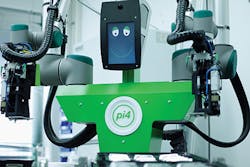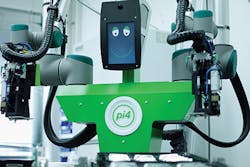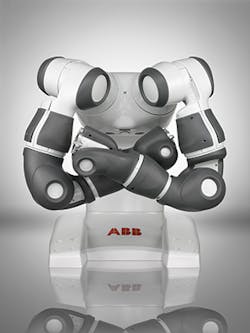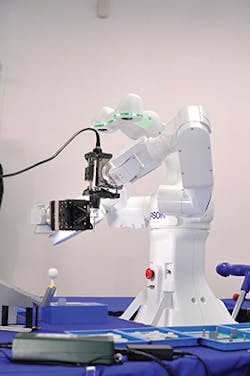Robots increase manufacturing productivity
Combining the cognitive abilities of human operators and robots will increase the productivity of automated manufacturing processes.
Andrew Wilson, Editor
Robotic systems are now commonplace in many automated manufacturing processes. In the automotive industry, for example, such systems are used for the assembly of engines, transmissions and axles, as well as car body painting and welding. When deployed, these systems both relieve human operators of such hazardous, highly repetitive and manually taxing tasks while increasing the productivity of manufacturing production lines.
Traditionally, such robotic-based systems have been separated from human workers by safety guards to prevent injuries caused by fast-moving robot operations. While beneficial, such approaches can result in decreased productivity if, for example, an operator must position work pieces within the work-space of the robotic cell.
Force limited
Because of this, manufacturers are now introducing a new generation of robots that employ torque sensors and vision systems to allow such robotic systems to work more closely with human beings. By combining the cognitive abilities of human operators and the potential of robotic automation, these so-called force-limited robots sometimes incorrectly called collaborative robots (or cobots) will thus increase the productivity of automated manufacturing processes.
Of course, having such robots work more closely with human beings will require rethinking of the safety standards currently in place. Currently, a number of standards exist that specify the requirements and guidelines for the inherent safe deployment of industrial robots. These describe the basic hazards associated with their operation and methods to eliminate or adequately reduce such hazards.
One of the most important of these standards-the ISO 10218 safety requirements for industrial robots standard from the International Organization for Standardization (ISO; Geneva, Switzerland; www.iso.org)-has been adopted by a number of other organizations around the world. These organizations include the American National Standards Institute (ANSI; Washington, DC, USA; www.ansi.org) and the Robotic Industries Association (RIA; Ann Arbor, MI, USA; www.robotics.org) with the ANSI/RIA R15.06-2012 American National Standard for Industrial Robots and Robot Systems standard and the Canadian Center for Occupational Health and Safety (CCOHS; Hamilton, ON, Canada; www.ccohs.ca) which publishes the CAN/CSA-Z434-03 (R2013) General Safety Requirements for Industrial Robots and Robot Systems.
Although the ISO 1028 defines certain safety requirements, for collaborative human/robot operation to become fully accepted, further standards will be required. Because of this, the ISO is currently working on supplementing and specifying additional requirements for collaborative industrial robots. This ISO/Technical Specification (TS) 15066 will contain limits for impact forces and pressures which might lead to an injury in case of human/robot collisions.
While every robotic system could be termed collaborative, those that are not force-limited must often employ safety guards or vision systems to allow them to operate alongside human beings. However, this is not always the case. Many industrial tasks are performed with heavy and cumbersome manual tools which can be strenuous to operate when used repeatedly.
Power tools
By employing robotically-assisted systems that are somewhat akin to using power tools, the effort to perform manual tasks can be dramatically reduced. Recently, such human-assisted systems have found applications as diverse as semiconductor manufacturing and de-boning meat. At RB3D (Auxerre, France; www.rb3d.com), for example, the company has developed a system that uses a Cobot 1A30 robot to assist an operator in the insertion of power electronics components. A video of the system in operation can be viewed at http://bit.ly/1FyKY7T.
A similar power-assisted robot co-developed by Kinea Design (Evanston, IL, USA; www.kineadesign.com) and Scott Technology (Dunedin, New Zealand; www.scotttechnology.com.au) has been designed for beef de-boning. The HookAssist system is designed to reduce the physical demands of workers who de-bone large cuts of meat in processing plants.
Just as power steering amplifies the steering effort exerted by a driver, if an operator pulls with 10 pounds of force, HookAssist pulls with 100 pounds. A two-axis power-assist on the hook does 90% of the work of pulling, tearing, and/or lifting large sections of cut meat while allowing four additional axes of motion. A video of the system in operation can be viewed at http://bit.ly/1vEMNzP.
While such power-assisted systems are collaborative, a number of companies are now developing robots to work side-by-side human operators without requiring traditional safety protection systems. Instead, these force-limited robots often run at slower speeds with reduced payloads. To ensure that no serious injuries to human operators occurs, such robots employ sensors to detect external forces and rounded and sometimes padded surface areas to reduce the effect of any impact should it occur.
Robotic arms
Developers wishing to integrate these robots into their systems now choose from a number of single-arm, dual-arm sub-systems and fully integrated subsystems that combine robotic and machine vision capabilities. Single-arm robots, such as the LBR iiwa from KUKA Robotics (Shelby Township, MI, USA; www.kuka-robotics.com), the UR5 and UR10 collaborative robotic arms from Universal Robots (Odense S, Denmark; www.universal-robots.com) are currently available while a prototype "green" collaborative robot arm from Fanuc America (Rochester Hills, MI, USA; www.fanucamerica.com) will be released this year.
With torque sensors in every one of its seven axes, the collision sensitivity of the LBR iiwa robot has been demonstrated by showing an end effector attached to the robot approaching a raw chicken's egg at speeds of 50mm/s (http://bit.ly/1EgwW9I).
Like the LBR iiwa, Universal Robotics' six-axis UR5 and UR10 also meet the requirements specified of the ISO 13849:2008 standard. This is accomplished by monitoring the joint position and speed, tool center point (TCP) position, orientation, speed and force and the momentum and power of the robot.
While Fanuc, KUKA Robotics and Universal Robotics are perhaps the best-known suppliers, other less well-known companies also offer single arm collaborative robotic systems. F&P Robotics (Glattbrugg, Switzerland; www.fp-robotics.com), for example, currently offers two versions of its P-Rob series - the P-Rob 1R and P-Rob 1U that offer six and four degrees of freedom respectively and support the open source Robot Operating System (www.ros.org). For its part, gomtec (Seefeld, Germany; www.gomtec.de) has developed three versions of its six-axis robot dubbed Roberta, each with different payload capabilities (up to a maximum of 12kg) and reach capability (up to 1.2m).
Dual-arm configurations
While such single-arm robots can be used in dual-arm configurations, applications such as components assembly can benefit from the use of collaborative dual-arm robots. Like their single-arm counterparts, these dual-arm configurations are configured with force sensors that allow them to be operated alongside human beings without safety guards.
Unlike single-arm configurations, however, these robots often employ vision systems that can identify the presence of human beings and/or allow them to identify the position and orientation of objects within their field of view.
Today, a number of companies have already announced such robots while others will be introducing similar systems very soon. One of the first companies to do so was Rethink Robotics (Boston, MA, USA; www.rethinkrobotics.com) with its Baxter dual-arm collaborative robot. With seven degrees of freedom in each arm, the robot is equipped with three cameras, one in either arm and one on the head of the robot. In addition, an infrared sensor is employed to detect whether a human operator is within a 1.5-15in range of the machine.
Already, the robot has been deployed for a number of disparate applications including emptying completed cartons from a rotating heat press blister packaging machine and placing them on a conveyor. A video of the robot performing this task at Praxis Packaging Solutions (Grand Rapids, MI, USA; www.praxispackaging.com) can be viewed at: http://bit.ly/1EgN8rO.
With six degrees of freedom in each arm, the Workerbot3 from pi4_robotics (Berlin, Germany; www.pi4.de) meets the requirements set forth in ISO 10218 and features an optional vacuum gripper with integral 5MPixel GigE industrial camera for recognizing the position of objects within its field of view (Figure 1). Like Rethink Robotics, pi4_robotics has also demonstrated the robots use in an automated manufacturing process. Here, 3D parts produced in an injection molding machine were passed to a workerbot3 robot from pi4 equipped with integrated optical part position and orientation recognition. The robot then laid the parts in a coating machine where the moldings received a homogenous thin chrome coating. The workerbot3 then took the coated parts, checked the optical quality with an inspectoid-M1 inspection system from pi4 and laid down the inspected parts in a tray.
Developed in collaboration with the National Institute of Advanced Industrial Science and Technology (AIST; Tokyo, Japan; www.aist.go.jp), the Nextage collaborative robot from Kawada Industries (Tokyo, Japan; http://nextage.kawada.jp) also features six-degrees of freedom in each arm. A stereo camera attached to the "head" of the robot detects changes in the work environment and allows the robot to adapt to changes in the production line environments while cameras at the ends of both arms help determine the specific position of the object being worked on.
Under development
While the Baxter, Workerbot3 and Nextage collaborative robots are currently available, other companies - notably ABB (Zurich, Switzerland; www.abb.com), Seiko Epson (Nagano, Japan; http://robots.epson.com) and Nachi (Novi, MI, USA; www.nachirobotics.com) are looking to introduce similar products very soon.
Commercially launched this month at Hannover Messe in Germany, ABB's YuMi (you and me) is a dual-arm robot designed for applications such as small parts assembly, where people and robots work hand-in-hand on the same tasks (Figure 2). The robot has soft, padded dual-arms and force-sensing technology to ensure the safety of human co-workers.
Like ABB, Seiko Epson has already announced an autonomous dual-arm robot prototype equipped with vision and force sensing functions that the company plans to commercialize by March 2016 (Figure 3). According to Seiko Epson, the robot can autonomously execute tasks by recognizing the position and orientation of objects in 3D space. The two robot arms will be supplied with a multipurpose end-effector that can grasp, clamp and insert objects of various shapes and sizes.
Stereo vision will also be featured in a collaborative robot now being readied by Nachi. With six degrees of freedom in each arm, the "head" of the concept robot features a stereo camera. The robot was first demonstrated at the 2013 International Robot Exhibition trade show in Tokyo Japan assembling a vacuum cleaner. A video of the robot performing this task can be found at: http://bit.ly/1zI1m0n.
Companies mentioned
ABB
Zurich, Switzerland
www.abb.com
American National Standards Institute (ANSI)
Washington, DC, USA
www.ansi.org
Canadian Center for Occupational Health and Safety (CCOHS)
Hamilton, Ontario, Canada
www.ccohs.ca
Fanuc America
Rochester Hills, MI, USA
www.fanucamerica.com
F&P Robotics
Glattbrugg, Switzerland
www.fp-robotics.com
gomtec
Seefeld, Germany
www.gomtec.de
International Organization for Standardization (ISO)
Geneva, Switzerland;
www.iso.org
Kawada Industries
Tokyo, Japan
http://nextage.kawada.jp
Kinea Design
Evanston, IL, USA
www.kineadesign.com
KUKA Robotics
Shelby Township, MI, USA
www.kuka-robotics.com
Nachi
Novi, MI, USA
www.nachirobotics.com
National Institute of Advanced Industrial Science and Technology (AIST)
Tokyo, Japan
www.aist.go.jp
pi4_robotics
Berlin, Germany
www.pi4.de
Praxis Packaging Solutions
Grand Rapids, MI, USA
www.praxispackaging.com
RB3D
Auxerre, France
www.rb3d.com
Robotic Industries Association (RIA)
Ann Arbor, MI, USA
www.robotics.org
Rethink Robotics
Boston, MA, USA
www.rethinkrobotics.com
Scott Technology
Dunedin, New Zealand
www.scotttechnology.com.au
Seiko Epson
Nagano, Japan
http://robots.epson.com
Universal Robots
Odense S, Denmark
www.universal-robots.com



